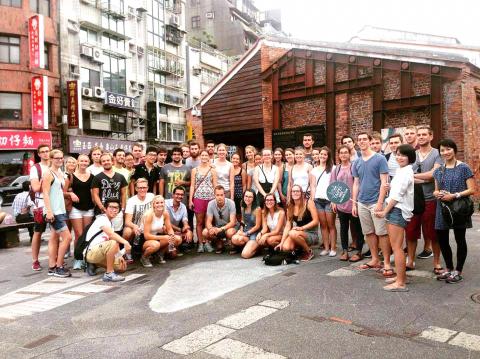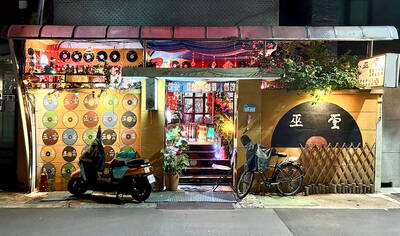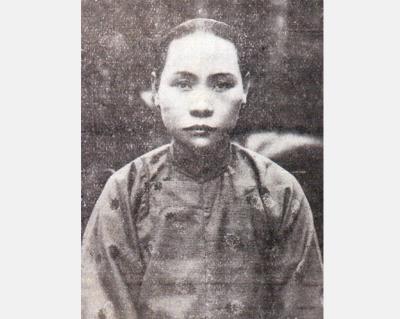When Becky Liu (劉樾) visited the Plum Pavillion (梅亭) in Taipei’s Beitou District (北投), it reminded her of her great-grandfather, who, like the pavilion’s former resident, former Control Yuan president Yu You-jen (于右任), was an expert calligrapher.
“Through this connection, I can tell [tourists] about calligraphy in our culture and what it represents,” she says.
This is one of the personal experiences that local tour guides will relate during Sunday’s Beitou, Hundred Years a day walking tour, organized by Like It Formosa (來去福爾摩沙), formed by a group of twenty-something locals dedicated to a variety of walking tours all conducted in English.

Photo courtesy of Like It Formosa
“We want our guides to not read from a book but to incorporate their personal experiences and serve as storytellers and performers,” says founding member Julia Kao (高于晴). “We want to present to foreigners the perspective of local young people.”
She adds that visitors have joined the same tour multiple times just to hear different tour guides share their experiences.
Formed early last year, Like It Formosa started out last September and October with two pay-as-you-want weekly walking tours of Taipei — a historic one every Thursday that takes people through the old Taipei neighborhoods on the western end, and a modern one every Sunday that shuffles through the bustling East and Xinyi districts from Sun Yat-sen Memorial Hall to 44 South Village (四四南).
They launched their first paid tour in November — an LGBT Taipei one that took visitors to locations such as an LGBT bookstore and Rainbow Sauna (彩虹會館), a 24-hour gay establishment. Sunday’s Beitou tour is their first time taking people to northern Taipei, and they have more tours planned for later this year.
These young Taiwanese aren’t just looking to show foreigners what Taiwan is about. They say it’s also a self-exploration of what it means to be Taiwanese, which is a question local students especially struggle with when asked to present their culture while studying overseas.
“When I went on the tours myself, I felt pretty impacted,” Kao says. “To locals, it’s a chance to get to know Taiwan all over again.”
“When we pass by the Presidential Palace, we can discuss the protests and democracy in Taiwan,” Liu adds. “In Ximen, we can talk about Japanese influence on the city. Through exchanges with tourists, we can in turn ponder deeper questions about where we live.”

The Lee (李) family migrated to Taiwan in trickles many decades ago. Born in Myanmar, they are ethnically Chinese and their first language is Yunnanese, from China’s Yunnan Province. Today, they run a cozy little restaurant in Taipei’s student stomping ground, near National Taiwan University (NTU), serving up a daily pre-selected menu that pays homage to their blended Yunnan-Burmese heritage, where lemongrass and curry leaves sit beside century egg and pickled woodear mushrooms. Wu Yun (巫雲) is more akin to a family home that has set up tables and chairs and welcomed strangers to cozy up and share a meal

Dec. 8 to Dec. 14 Chang-Lee Te-ho (張李德和) had her father’s words etched into stone as her personal motto: “Even as a woman, you should master at least one art.” She went on to excel in seven — classical poetry, lyrical poetry, calligraphy, painting, music, chess and embroidery — and was also a respected educator, charity organizer and provincial assemblywoman. Among her many monikers was “Poetry Mother” (詩媽). While her father Lee Chao-yuan’s (李昭元) phrasing reflected the social norms of the 1890s, it was relatively progressive for the time. He personally taught Chang-Lee the Chinese classics until she entered public

Last week writer Wei Lingling (魏玲靈) unloaded a remarkably conventional pro-China column in the Wall Street Journal (“From Bush’s Rebuke to Trump’s Whisper: Navigating a Geopolitical Flashpoint,” Dec 2, 2025). Wei alleged that in a phone call, US President Donald Trump advised Japanese Prime Minister Sanae Takaichi not to provoke the People’s Republic of China (PRC) over Taiwan. Wei’s claim was categorically denied by Japanese government sources. Trump’s call to Takaichi, Wei said, was just like the moment in 2003 when former US president George Bush stood next to former Chinese premier Wen Jia-bao (溫家寶) and criticized former president Chen

President William Lai (賴清德) has proposed a NT$1.25 trillion (US$40 billion) special eight-year budget that intends to bolster Taiwan’s national defense, with a “T-Dome” plan to create “an unassailable Taiwan, safeguarded by innovation and technology” as its centerpiece. This is an interesting test for the Chinese Nationalist Party (KMT), and how they handle it will likely provide some answers as to where the party currently stands. Naturally, the Lai administration and his Democratic Progressive Party (DPP) are for it, as are the Americans. The Chinese Communist Party (CCP) is not. The interests and agendas of those three are clear, but